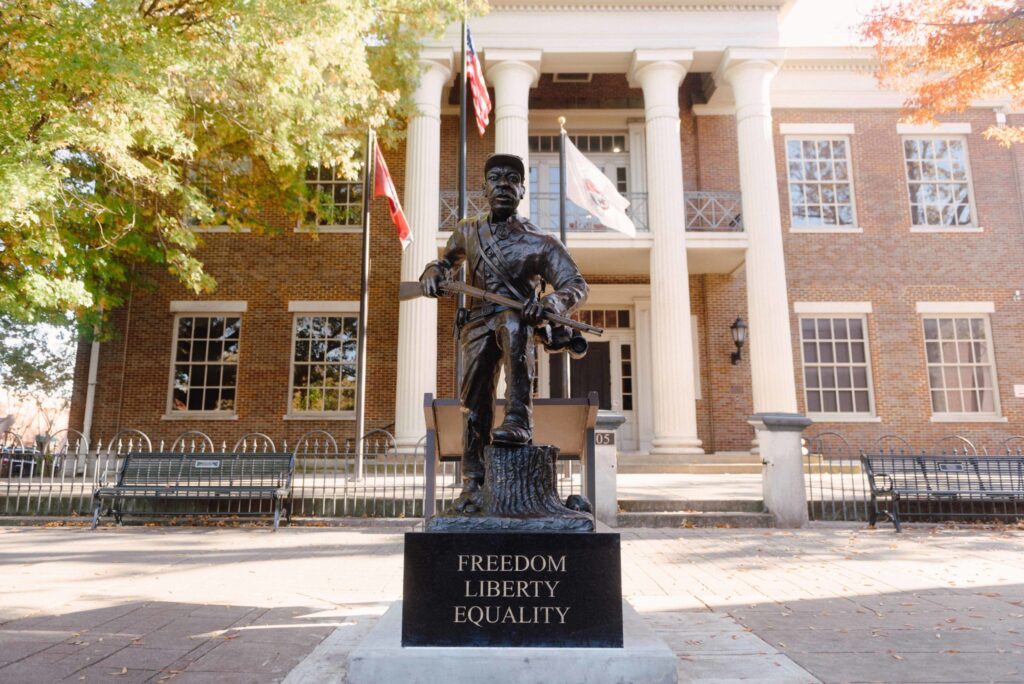Three pastors and a historian walk into City Hall.
That’s not the opening line to a joke; it’s the action that started a movement in Franklin, Tennessee. That movement is recognized across the nation, but it wasn’t always that way. Franklin has a complex history that is no secret. Many know it was famously the site of a Civil War battle, The Battle of Franklin. It was also home to a fateful meeting between President Andrew Jackson and American Indians that also took place in downtown Franklin’s Hiram Masonic Lodge, ultimately leading to the Indian Removal Act.
Until recently, what many didn’t know was Franklin’s story of black residents. Franklin’s “full” history wasn’t as widely known or easily accessible. That has now changed thanks to the efforts of those three pastors, a local historian, and a supportive community.
Today in Franklin’s public square, like in many Southern cities, stands a monument to Confederate soldiers. Unlike many other cities, though, in downtown Franklin stands a life-size bronze statue named March to Freedom honoring U.S. Colored Troops. It is joined by additional history markers telling the stories of a market house where enslaved people were sold, a race riot in 1867, black men’s role in reconstruction, and a factual narrative on the Battle of Franklin.

HOW DID THE FULLER STORY COME ABOUT
In the wake of tragic events at a rally in Charlottesville, Virginia, in 2017, Franklin area pastors and community leaders of all races gathered for a prayer vigil around Franklin’s public square. In that crowd were pastors Chris Williamson and Kevin Riggs. Also in that crowd just observing was Battle of Franklin Trust COO & Historian Eric Jacobson. The pastors on that night were saying it was time for Franklin’s confederate monument to come down.
From that gathering, discussions between those three men and local pastor Hewitt Sawyer began about how all aspects of Franklin’s history were not adequately acknowledged in the downtown square. There was a monument to Confederate soldiers who died in the Battle of Franklin, but nothing noted the other challenges faced by enslaved Black people through the years in that same public square. In those regular talks over coffee and over the phone continued, the conversation’s narrative shifted from discussing why the confederate statue should be removed to why it was imperative to add to the story being told in Franklin’s downtown. To tell a more complete version of the story. Sadly, some of that story was lost to history over the years, so the “full” story can never be told, but the telling of as much of that story as possible – the ‘fuller’ story – would begin in earnest.
Following those conversations, Sawyers, Williamson, Riggs, and Jacobson rallied support from local government officials and the community for what would be known as The Fuller Story Project. It was a two-phase plan to install additional markers around the public square then raise funds for a USCT statue. The project was not without some obstacles, though. Lawsuits were filed by the local chapter of the United Daughters of the Confederacy about land ownership where the statue and markers would be installed. After the legal cases were settled, the five markers of phase one were publicly unveiled in October 2019.
BUILDING A STATUE
The next phase of the Fuller Story project was to raise $150,000, find a sculptor, and unveil a statue honoring USCT soldiers on Franklin’s public square. The funds needed were raised through community-wide fundraising efforts, and the Paris, Tennessee-born sculptor Joe Frank Howard was selected to craft the statue.
Howard began work on the “March to Freedom” statue at his home in Columbus, Ohio. As he was crafting it, its messages began to take shape. The soldier depicted stands holding a rifle with his foot atop a tree stump where broken shackles lay beneath it, signifying the soldier’s release from the bondage of slavery. The soldier’s face, weary from a long fight both on the battlefield and before, gazes forward with a sense of determination for the future.
In November 2021, before hundreds gathered in the public square, “March to Freedom” was unveiled outside the same courthouse where hundreds of those USCT soldiers honored walked through the doors to enlist. When it was unveiled, it gave so many black individuals the ability to finally see a statue of someone that looked like them in their community, honoring the history they know, and sharing it with others.
On that day, community leaders praised the work of the Fuller Story Project, and each of the pastors and Jacobson shared what it meant for the statue to stand in Franklin. When describing what the statue means, Williamson said, “This statue represents the nearly 200,000 men who bravely fought for our country, for their freedom, and for the freedom of 4 million enslaved people in our country. This statue means hope, it means courage, it means possibility, it means dignity, it means valor.
Pastor Sawyers added, it means a new day.”
EXPERIENCING THE FULLER STORY
Now that the statue and markers have been added to Franklin’s public square, there are many ways a visitor can experience them and learn more. There are guided walking tours of downtown Franklin that tell the “Fuller Story” through Franklin on Foot and Franklin Walking Tours. There are also self-guided digital options available through Visit Franklin’s free Great American Main Street passport, and coming in the spring are extended tours through the Battle of Franklin Trust.









